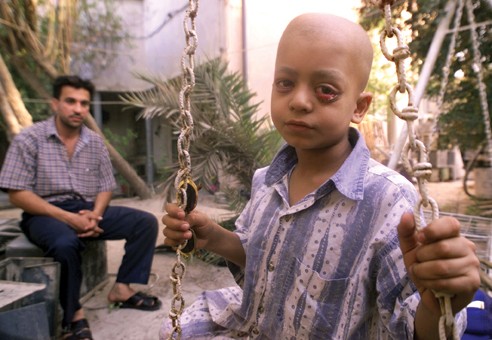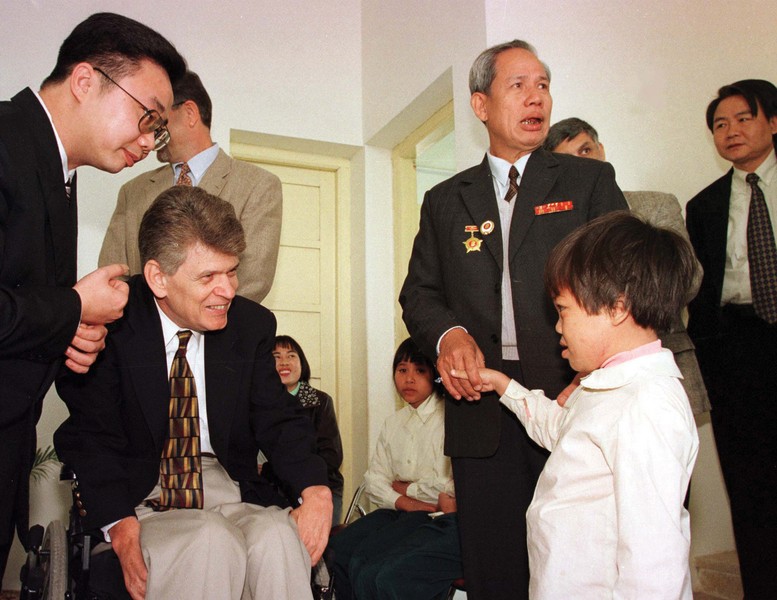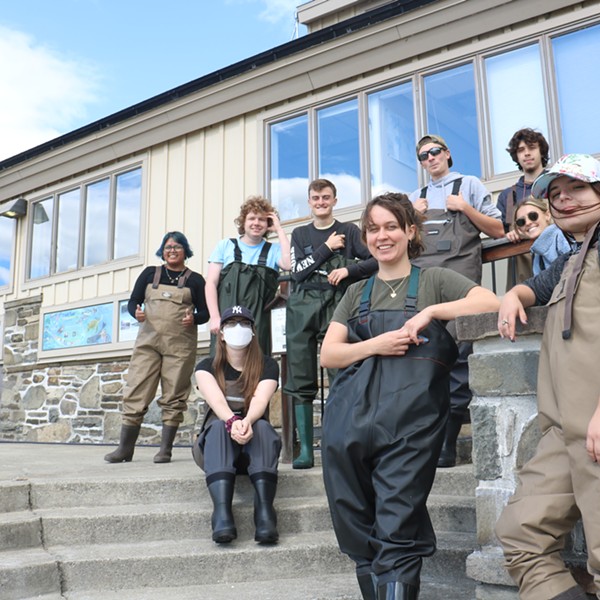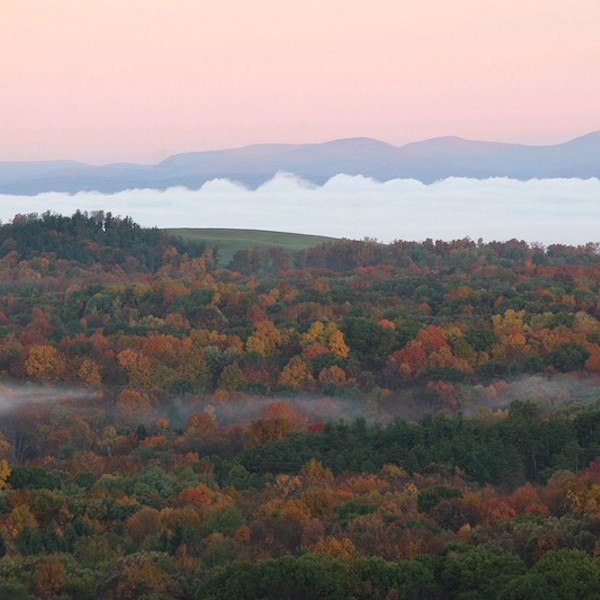War is a known evil. It kills people, destroys precious infrastructure invaluable to the quality of human life, and uproots civilian populations. Mines and undetonated ordinance lying hidden take life and limb long after a peace has been forged, as do poisonous compounds from detonated bombs, and biological and chemical weapons that infiltrate air, soil, and water supplies, and eventually the human body.
Such effects are seen as atrocities and share a common political focal point—the effect of war on the human species. This is a shared foundation on which public heartstrings are pulled and anti-war or peace activists rally. Outrage is still expressed at the US government’s use of Agent Orange during the Vietnam War. Dubbed “land ghost,” it is estimated that 400,000 Vietnamese were either killed or maimed by the toxic defoliant, an estimated 500,000 Vietnamese children born with related birth defects, and another 200,000 people suffer its cancers. And billions were spent on health care for Agent Orange-impacted US veterans. However, this outrage has made invisible any commentary addressing the negative impacts the defoliant had on Vietnamese ecosystems.
After the Persian Gulf War, anti-sanctions activists in the West railed against the unleashing of deadly depleted uranium (DU) by the US during that war, and for years claimed the deposited DU was the cause of a cancer cluster in Iraq’s south. Photos of horribly deformed Iraqi children caused an international outcry and obliterated investigation into other possible environmental or political culprits. A now emerging Iraqi view says that perhaps unchecked factory emissions, raw sewage, and other pollutants flowing down the Tigris and Euphrates rivers to Iraq’s southern marshlands—95 percent of which were purposely desiccated by a Saddam Hussein hell bent on killing the Shiite population—were responsible for the cancer cluster. Not only causing hundreds of thousands of people to flee the region, the drying of the marshlands, an area the size of Massachusetts, eradicated the marsh reeds that acted as a natural bio-filtration system. Pollutants gathered in stagnant pools that people drank from and bathed in. Marsh ecosystems were also severely affected, and pollution was suddenly being found miles out into the Persian Gulf, affecting sea life. Antiwar rhetoric aimed at vilifying the US use of DU continues to ignore this perfect storm of events that has since been defined in scientific communities as an ecocide of historic proportions.
Rarely are the adverse effects of war on nonhuman life focused on. Yes, we hear about accidentally unleashed zoo lions wandering war torn city streets. Or the application of dioxin-containing herbicide defoliants on trees; not the jungle and the entirety of nonhuman life it contains—just the trees. But even more rare is news aired or outrage expressed at damage done to such things as soil or the benthic invertebrates found in water bodies. Both are crucial environmental indicators.
More often that not, the more visible effects of war on the human species becomes the centerpiece of all efforts to bring lasting peace. The horrible tales of damage to humanity is met with calls to end the violence and for retribution. Those responsible for bringing on the fight are vilified.
Yet it is generally accepted that peace can cause more damage to the environment than war. But how can we know this to be true, since so little effort has been directed at studying environmental damage during wartime, says Jurgen Brauer, professor of economics at the James M. Hull College of Business, Augusta State University, fellow and former vice-chair of Economists for Peace and Security, and co-editor of the Economics of Peace and Security Journal. In his soon-to-be released book, War and Nature: The Environmental Consequences of War in a Globalized World (AltaMira Press), Brauer addresses the harm peacetime reconstruction and socioeconomic development have on the environmental infrastructure that supports human life, and the importance of accurately measuring the environmental consequences of war and separating out the putative from real effects. In June, senior editor Lorna Tychostup interviewed Brauer in Bangkok via Skype.
You are an economist. Why write a book about war and the environment?
There are three reasons. One, I am an economist studying the economics of war and peace, but am also an amateur biologist, ecologist, environmentalist, a scuba instructor and underwater photographer, a motorcyclist, and a lover of the outdoors. So you can say that I have private passions that I combine with my professional work on war and peace. Second, once there is environmental damage in war, an economic evaluation of that damage is needed in order to be able to claim restitution for the damage done before a court of [international] law. Third, some years ago UNESCO asked me if I could put together an edited volume on war and peace. While outlining it with my coeditors, we agreed to include a chapter on the environmental impact of war. I volunteered, falsely believing I could just go to the library, pull things off the shelf, and sum up the literature in a 3,000-word essay. Eleven years later I have my own book. The subject matter turned out to be far more complex than anticipated.
You focus intensely on two places: the Persian Gulf and Vietnam, two US-driven war zones. Why these two places as opposed to say, the Sudan, Congo, or Afghanistan?
In the chapter on civil war I do write about Rwanda and Afghanistan. The more substantive answer is that I was absolutely single-minded in tracking down scientific literature and evidence, and after spending years and years researching, I found that most of the literature concerns US wars. Other countries simply don’t fight as many wars. Also, the US military is under more democratic control—strange as that may sound—than the militaries of other countries. So whenever there is a US war and a US soldier is injured in that war, almost immediately US congressmen and other people want studies and investigations done pertaining to that war, which they mandate the Department of Defense [DoD] or someone to conduct. For example, the DoD may give the necessary financial resources to the National Academy of Sciences or some other institution to send in scientists to collect data, which often ends up in the public realm. So there is more data to examine for US wars than for non-US wars.
Specific to the Persian Gulf War, you talk about how scientists’ reports suggest a fair amount of environmental disruption and damage, some long-lived. But then you suggest that the larger part of this damage is attributable to pre- and post-war peacetime commerce rather than the war itself.
Simply looking at the scientific literature, whether measuring the particulates in the smoke plume from the oil fires or the effects of the oil spill in the Persian Gulf marine environment, the scientific evidence shows differences in the environment. However, the actual damage observed was relatively small. This is contrary to the visual impression we had viewing the televised oil fires. Just because we have a visual impression that generates a certain amount of horror in us does not mean, scientifically speaking, that actual damage was done. When the scientists went in and tried to measure the damage, they also began to measure what happened pre-, during, and post-war. Comparing this data, many observed that so-called peacetime economic development generated more damage than the war itself. Put in the perspective of time, the war was a relatively short war—it was over after a couple of months. Therefore there is a limited amount of damage it could have done. But in peacetime, you can have economic development going on years and years, wiping out the environment: installation of oil facilities, dredging more channels for oil ships to enter harbors, and the creation of tourist areas that eliminate mangroves—things of that nature. And that may be one of the reasons why the environmental movement and the anti-war movement never quite got together because what you do in peacetime to nature is indeed very harmful from the perspective of nature, and quite possibly more harmful than what can happen to nature in war.
Peace activists railed against the Persian Gulf War. Media coverage, especially visual, certainly shed light on the possibility of environmental damage. But all damage was blamed on wartime activities and the US. No attention was given to what Iraq had done environmentally to itself or to the Persian Gulf. How can the peace and anti-war communities better educate themselves or better direct their activities?
I am both anti-war and pro-environment, and I have kept my eye on both movements. Most people do just one or the other. You may be an anti-war activist and that’s where most of your activities are directed. You may be also pro-environment in your personal life but not in an activist way. And vice versa. A lot of people who are involved in pro-environment issues, mostly on the local level, may be anti-war at the same time, but not in an activist way. The two communities rarely coincide because each individual decides to be active in just one or the other area. I have no direct suggestion other than to get the point out to both communities there that there is an overlap between the two, and that as a practical matter, there needs to be some sort of joint action or consideration.
How realistic is that? Both before and during this last buildup to war in Iraq, the anti-sanctions community made quite clear the argument that depleted uranium (DU) leftover from the First Gulf War was responsible for a cancer cluster in Basra that produced horrible birth defects and premature deaths. The head of an Iraqi environmental organization who grew up in the Basra region agrees there could be some DU in the area. But he cautions that we also have to look to the environment where unchecked pollution from factory emissions and raw sewage freely flowing into the Tigris and Euphrates rivers was coupled with the purposeful drying of the marshes by Saddam Hussein. People bathed and drank from stagnant pools containing this toxic mix, which could very well be the true cause of the cancer cluster. This news does not sit well with the agenda of the anti-war movement that continues to use the DU issue to support their actions, which does nothing to truly help the very people they claim they want to help. So how realistic is collaborative effort between environmentalists and the anti-war community?
I fully agree. That’s why I said at the beginning that people specialize and become anti-war, or pro-women and children, or whatever pro- or anti- you can be. And to some degree that makes sense because we all have limited time, energy, financial resources, and intellectual capabilities to become knowledgeable in one area or another. But there are dangers in specialization in that you focus on one end but maybe overlook important things in other issue areas. It would be good to collaborate. I am one of the few who has investigated two areas at the same time. As a scholar, all I can do is put my findings forward to the readers and hope they become inspired.
You talk about the size of wars using the terms “big wars” and “small wars.” How does the size of a war effect the environment?
We don’t know. Given the limited evidence—there is only a very small number of wars that can be studied from a scientific perspective—it appears that the so-called “big wars” such as the Persian Gulf War or the Vietnam War have had a relatively limited effect. We do not study all of the effects that these wars could have had, so there is quite possibly a big misperception here. A “big” war can appear to have only a “small” effect because we study only one or another of the potential environmental impacts. On the other hand, what we call “small” wars, such as civil wars, often are in fact very big wars, although they may not be very big in the eyes of the international media. The war in Southern Sudan went on for decades and no one in the West even noticed. The only war we noticed in the Sudan was the Darfur War. But the war in Southern Sudan was “big” on the ground yet “small” in the media. The terms big and small are perceptional. So-called “small wars” or unattended wars may in fact have very large effects, in large part because of the refugee flows they generate. And so-called “big wars” may have generated small environmental effects, perhaps merely because we don’t study all of their potential effects.
A war occurs. Hundreds of thousands of people are displaced across the border into another country or countries. You state that a lot of research has looked into adverse effects—depletion of resources, increases in pollution, and so forth—that displaced populations have on the environment they move into. Yet no research gets done on the region they have left. Is such research important? Why?
From a purely logical point of view, if refugees are driven out of Place A and into Place B, research done in Place B, where there may be some environmental or ecological damage done, needs to be complemented by research in Place A, where the people are coming from. If you eliminate human habitation in Place A, logically speaking, non-human life should be able to recover there. So, on a purely logical scientific basis, if people move from A to B, we should study not only what happens in B, but also what happens in A, because whatever losses there are due to the refugee influx in Place B, might be compensated for in Place A, where the refugees are coming from. I know this sounds harsh because people are highly concerned about what happens to the refugees. I acknowledge that and fully sympathize. But from an ecological point of view, if you take humans out of the equation and ask, “What happens to the remainder of nature—non-human nature?” surely you would want to know what happens in the places the refugees leave. Nobody, to my knowledge, has ever looked into these areas.
Okay, this hypothetical war ends and some of the hundreds of thousands of displaced people return home. Has it been studied whether the actions they take to regain economic stability are more damaging to their home environment than the actions that occurred during the war?
Not to my knowledge, no. My embarrassment as a member of the scientific community—but I suspect that there is even more embarrassment among the ecologists and environmentalists—is how little these refugees have been studied. It is really astonishing to note how little we know. We have one study out of Mozambique showing that as refugees returned to their home areas, the transportation route they took coincided with a vector of bushmeat hunting. The return movement caused a lot of wildlife destruction. But to my knowledge there are no studies that compare whether the resettlement of these areas induces additional damage on the environment.
Can you explain the term “conservation by default?”
That is a bit of an ironic, tongue-in-cheek phrase I use in the book. I refer to cases such as Ethiopia, when there was a war going on in the highlands. Ethiopia, as many of the other countries like Rwanda, Uganda, and the Sudan, is not particularly flush with money to begin with. The government funded environmental programs, but with the war going on, funds allocated to environmental conservation were shifted into the war. That’s conservation by default, which basically means the complete abandonment of what little conservational structure they had. No funding. No payment of game wardens. Lands may be protected on paper but not in practice.
You give the example of overwhelmed relief workers dealing with people in need and discuss how non-human conservation issues go by the wayside, and how this annoys conservation groups. Is it possible, important, or even realistic to attend to conservation issues during times of war-related crisis?
It’s important, definitely. But I don’t know if it is realistic. That’s up to the people who read the book, especially if they work in the relevant agencies. I make a case that human rights, humanitarian emergency assistance, economic development, refugee, and natural resource conservation groups need to have a roundtable or council collaborating and coordinating their various actions. Again, I am an outsider. I am an economist, so I have no idea whether that is realistic or not. What I see happening as an outsider is that coordination is definitely needed in order to prevent additional damage as a consequence of war as you are trying to help the people in these areas. But whether the relevant people will actually get their act together is another question.
War changes the landscape and affects the environment. But yet, and this has been my personal experience working in Iraq, as people reenter a war-ravaged area, historically, there has been no solid environmental or sustainable plan in place—no blueprint for how to go about reconstruction or to restore an environmentally sound life. The Iraqi environmental organization I mentioned has actually been working to baseline conditions in Iraq since 2003, but there is no blueprint in place to address the environment in a conflict zone. How would you suggest a blueprint be created? Are there steps that should be taken? Is there an order to these steps?
I make a strong statement that after the war is done, after the weapons fall silent, people go back to their home areas and no one really pays any attention to the physical environment to which they return. Post-conflict economic recovery concerns fiscal, monetary, and labor policy and the like. But nobody really talks about the environmental situation to which these people return. Emergency recovery plans exist for the western industrial countries—such as England, Japan, Germany, the US, and Canada—and if you have a hurricane come through, or a flood or a tornado wipes out a city, there are plans in place to restore the environment, both human and nonhuman. I feel we can learn from these plans and apply them to developing or emerging countries in war, and post-war. But to my knowledge nobody has tried to do that. In a way I am pointing yet another finger at yet another failing. I do a lot of finger pointing in the book, I suppose. Who might feel encouraged to take responsibility to fill the gaps I identify remains to be seen.
On the positive side, I find it encouraging—especially after 1991, when nobody studied what was going on in Iraq—that after 2003 people are finally recognizing that some damage was done there as well. Not just to the political entity of Iraq, but more importantly to its people and to their lands. Independent of what political entity we live in, we still need to study what happened to the people and the land. However, I am still very sad it did not happen in 1991. Iraq was just seen as “the enemy,” never mind its people and its lands.
Better late than never.
I agree. On the other hand, if better late than never, then why only Iraq? Why not everywhere else? It’s a political issue. It’s done in Iraq because it concerns the US and the club of Western countries and interests. But if it were somewhere in Uganda, nobody would care. In Uganda we have fellow human beings and a fellow environment that are just as worthy of attention as any other place in the world. There is an injustice here, or an unequal justice, that really riles me.
In the section of the book subtitled “A Way Forward” you lay out the outline of such a blueprint and state that there needs to be measurement, detection, and assessment. Soil should be looked at first, then water and, last, air. Species and their habitats should be examined. You state that rapid assessment of a region, ecological scaling, and bio-monitoring are relatively cheap ways of amassing a continuous stream of ground level data—a baseline—that would help to shed light on the effects of war should one come along, and that this assessment should occur before a war. Is that feasible? The world is large. How can one determine where a war will break out?
What I propose—Is it feasible? Does it make scientific sense?—ultimately will have to be evaluated by the readers in the field. That some sort of assessment is needed before corrections can be made or restorative action is taken obviously sounds very logical and sensible to me. But this idea will have to go through peer review in the larger community. Even now we have all kinds of satellites circling the Earth taking constant land-monitoring pictures for agricultural purposes, a constant evaluation is going on regarding weather patterns and storm patterns that is often beamed right down to the farmer sitting in his tractor in a field somewhere in Alabama. A lot of these tools, equipment, instrumentation, and techniques are already available and I don’t see why the conservation, scientific, and environmental communities cannot avail themselves of these tools to collect baseline pre-war data, which then in the case of war can be used for pre- and post-war studies. We would then know what was there before the war, assess what was done during the war, and based on the information, come up with restitution and recovery plans if damage did occur.
You talk about incentives in a global world. Why do they matter?
Incentives matter because they help direct attention to areas that so far are either not studied or understudied, they help to direct financial resources in particular, and human resources. I believe that part of the reason why the Persian Gulf War has been studied so well is because there was a fear that the smoke plume would rise into the jet stream and via the jet stream be distributed all over the world and affect people everywhere, including people in Canada, the US, and Western Europe. If I am sitting in the US and know I am going to be affected, then I have an incentive to lobby my congressional representatives to put forward the money to study what the effect really is. Only when people feel that they are personally affected do they work to make the resources available to study what is going on and maybe to prevent the next war. Incentives are incredibly important to ensure that the resources, both financial and in terms of scientific talent, are forthcoming.
What has concerned me throughout the many years I have researched the theme of war and nature, is that all of us specialize. And specialization has its advantages because we get to focus and become more knowledgeable in one particular area. But the more we specialize, the more we also leave behind neighboring areas that may be integrally connected to our own study area. What I hope my book will do, or has the potential to do, is to reconnect people and their activity and activism; inspire them to reach out from their own area of isolation and connect to somebody else in another area of isolation, and examine how things are related to each other, so that we don’t become “activist idiots”—that is, so focused on one issue area that we overlook that there are other issue areas to which our own issue is related. People need to become a little more holistic even in their activism. And I would like to see scientists be more aware that there are plenty of study areas open and to start to fill the gaps that I identify.
If they can get the funding.
Well, I took 11 years of my life and dedicated them to the subject matter with zero funding. Perhaps my book will encourage graduate students working on their PhDs to dedicate themselves to study the environmental effects of war. To my knowledge there is no such specialty niche in the life sciences. There is a whole career path here that awaits enterprising young scientists.
Each question I’ve asked you, you addressed through the logic of science. Yet I wonder how people will receive what you are saying.
I gave a set of lectures in South Africa six years ago and made the point that we only study what affects us in the West and how fundamentally unfair and unjust that is. People were thanking me, happy that at least one person in the West recognizes and sympathizes that people in Africa and their environments are just as valuable as people in the West and their environments. Wherever there is a war, there are people and an environment. All are equally eligible of our attention. That point was received very well. But the practical fact of the matter still is that the research funding is not forthcoming and will only be forthcoming if it suits the interests of the Western governments. So there is plenty of scope left to mix scientific passion with politics and justice, for humans and for their environment.


















